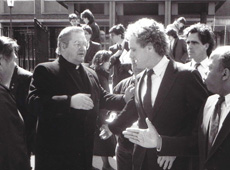Whither unionism, after so grave a setback?
Posted By: March 06, 2017
Today’s unionist leaders face challenges unthinkable to their predecessors such as Lord Carson
Sam McBride. News Letter. Belfast. Monday, March 6, 2017
Six and a half years ago, Arlene Foster contributed to a series of News Letter essays exploring where Northern Ireland should be on its centenary in 2021.
The vision which she articulated then was the antithesis of the campaign over which she has just presided.
Writing in 2010, Mrs. Foster said: “I always wanted a better, more strategic, confident and professional unionism.”
It was one of the rare occasions on which Mrs. Foster went on to set out something of her personal political ideology.
She said: “Our task for 2021 and beyond is to build a new shining city on the hill”.
Setting out a broad vision of Unionism which embraced those of all backgrounds, Mrs. Foster went on: “Unionism can have a breadth and depth of it that can make it relevant to more people than the narrowness and restrictiveness of Irish nationalism.”
Those words hardly reflect the campaign out of which we have just emerged.
Though Mrs. Foster no doubt feels it was born out of necessity because she could not fight an election either on her party’s record in government or on the RHI scandal, the DUP leader presided over an exceptionally orange and green campaign.
Far from re-energizing Unionism, that campaign has succeeded in driving Nationalists not only to the polling stations but to Sinn Fein.
The strategy certainly brought out some additional Unionist voters – the DUP’s vote was up by almost 23,000 votes.
But that paled into near insignificance when set beside Sinn Fein’s surge – up by a massive 57,460 votes.
Translated into seats, that saw Unionism lose 16 MLAs while Nationalism lost just one.
Now – inaccurately but in part due to her own actions – caricatured by many Nationalists as some sort of political ogre, Mrs. Foster may now realize that in her attempt to shift the focus of the election from RHI she has weakened Unionism and undermined her ability ever to fulfil the vision she set out in these pages more than six years ago.
But beyond Mrs. Foster’s personal future, where does Unionism go from such a bleak position? There are already calls for various forms of Unionist unity.
Those calls will intensify over coming months as the full significance of this election dawns upon the pro-Union population.
One of the surprising thing over recent days has been the number of traditional Unionists – some of whom are DUP members – who have cautioned against an attempt to recreate a single Unionist party.
Instead, the current mood appears to lean towards some form of closer working relationship between the disparate strands of Unionism.
Support for any such move towards unionist unity would be wildly popular among many Unionists across all pro-Union parties.
But, just as Mrs. Foster’s strategy of turning this election into an orange-green battle drove up Unionist turnout, such an outcome cannot be viewed in isolation. Nationalism would also react to any form of Unionist unity.
If unity were to involve a single party, it would be Unionism’s last stand; an option so radical and so unlikely to appeal to Catholics that no further action could be taken if it was belatedly found to have even further driven even more voters to Sinn Fein.
The fundamental difficulty of finding policy positions which would unite everyone from a fiscally conservative Free Presbyterian TUV counselor to a gay PUP member who believes in the redistribution of wealth would be impossible unless the party were to adopt bland, uninspiring positions.
And the point of parties is to govern – particularly in the era of devolved government as the UK drifts towards quasi-federalist system policies on health, taxation, and social issues are likely to become increasingly important in coming decades.
Already, many of the post-Troubles generation are uninspired by the concept of simply voting for someone because of their constitutional stance.
One further crucial element to this debate has fundamentally altered in recent months – the move towards oppositional politics at Stormont.
In this election, Ulster Unionist leader Mike Nesbitt grappled with some of the conflicts between that new reality and the choices which faced his predecessors since Lord Carson.
The advent of an official cross-community opposition at Stormont confounds the traditional unionist-nationalist divide to an extent which arguably makes unionist or nationalist unity impossible.
It would be ludicrous for the UUP to spend years in opposition denouncing the DUP‘s actions in government and then at election time to work closely with its rival.
Likewise, the SDLP would arguably have more in common with its UUP opposition partner in seeking to dislodge the governing parties than it would have with Sinn Fein which would be seeking to hold off such a challenge.
It was unionists who drove the campaign for an opposition, seeing it as a key element of a proper democracy along Westminster lines and, in some cases, as a potential route to forming an Executive which might not include Sinn Fein.
The implications for Unionist unity were never articulated at the time.
But, having yearned for that outcome and now got it, the new reality would seem to preclude the sort of pan-Unionist-front which many grassroots Unionists now want to see.
Instead, if the current oppositional structures are to remain, the future success of Unionism may depend on two parties setting out competing visions – perhaps alternative left-right or socially conservative and liberal stances – for making Northern Ireland that ‘city on a hill’.
As Peter Robinson acknowledged in 2012 but then found himself unable to deliver, with an increasing Catholic population, that outward-looking vision would seem to be the only strategic hope for keeping Northern Ireland within the Union.










